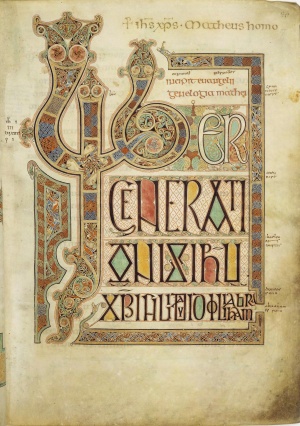Evanghelia după Matei
| Acest articol (sau părți din el) este propus spre traducere din limba engleză!
Dacă doriți să vă asumați acestă traducere (parțial sau integral), anunțați acest lucru pe pagina de discuții a articolului. |
Evanghelia după Matei (în greaca veche: Κατα Μαθθαίον sau Κατα Ματθαίον) este prima evanghelie din Noul Testament. Conform tradiţiei, ea a fost scrisă de Apostolul Matei, fost vameş care a devenit unul din cei doisprezece Apostoli, şi a dat mărturie despre lucrarea de mântuire a Domnului Iisus Hristos. Este considerată cea mai veche evanghelie scrisă.
Cuprins
Autorul şi scrierea Evangheliei
Cu toate că documentul este anonim - adică nu este nici o menţiune despre autor internă scrierii -, autoritatea acestei Evanghelii a fost atribuită în mod tradiţional Sfântului Matei. Mărturia care ni s-a transmis de la Sfinţii Părinţi este unanimă în această privinţă, iar tradiţia a fost acceptată de către creştini începînd cu secolul al II-lea până în timpurile moderne. În plus, titlul "După Matei" este găsit în primele codice, care datează din secolul al patrulea.[1]
Conform Tradiţiei, după Cincizecime Sfântul Matei a propovăduit Evanghelia Învierii Domnului în toată Palestina. Apoi "la cererea evreilor convertiţi din Ierusalim, Sfântul Apostol Matei şi-a scris Evanghelia descriind viaţa pământească a Mântuitorului înainte de a pleca să propovăduiască Evanghelia în ţinuturi îndepărtate." [2]. Acesta a plecat apoi sa-şi propovăduiască Evanghelia în Siria, Media, Persia, Parţia, înainte de a fi martirizat în Etiopia.
Deoarece a fost consemnată în Palestina, există atât presupuneri şi cât şi dovezi că Evanghelia lui Matei a fost scrisă iniţial în aramaică, cu toate că cea mai recentă versiune care a supravieţuit este în limba greacă. Conform OCA "multe particularităţi lingvistice şi cultural-istorice ale traducerii greceşti dau indicaţie despre aceasta [forma originală în aramaică a Evangheliei, n.n.]."[2] Aceasta a fost probabil scrisă undeva prin anii 60–65 d.Hr., cu toate că unii scolastici mai liberali spun 80–100 dHr.
Conţinut
For convenience, the book can be divided into its four structurally distinct sections: Two introductory sections; the main section, which can be further broken into five sections, each with a narrative component followed by a long discourse of Jesus; and finally, the Passion and Resurrection section.
- Containing the genealogy, the birth, and the infancy of Jesus (Matt. 1-2).
- The discourses and actions of John the Baptist preparatory to Christ's public ministry (Matt. 3; 4:11).
- The discourses and actions of Christ in Galilee (Matt. 4:12–26:1).
- The Sermon on the Mount, concerning morality (Matt. 5–7).
- The Missionary Discourse, concerning the mission Jesus gave his Twelve Apostles. (Matt. 10–11:1).
- The Parable Discourse, stories that teach about the Kingdom of Heaven (Matt. 13).
- The "Church Order" Discourse, concerning relationships among Christians (Matt. 18–19:1).
- The Eschatological Discourse, which includes the Olivet Discourse and Judgement of the Nations, concerning his Second Coming and the end of the age (Matt. 24–25).
- The sufferings, death and Resurrection of Jesus, the Great Commission (Matt. 28:16–20).
Teologie
The one aim pervading the book is to show that Jesus of Nazareth was the promised Messiah—he "of whom Moses in the law and the prophets did write"—and that in him the ancient prophecies had their fulfillment. This book is full of allusions to passages of the Old Testament which the book interprets as predicting and foreshadowing Jesus' life and mission. This Gospel contains no fewer than 65 references to the Old Testament, 43 of these being direct verbal citations, thus greatly outnumbering those found in the other Gospels. The main feature of this Gospel may be expressed in the motto "I am not come to destroy, but to fulfill" (Matt. 5:17). The Apostle Matthew preached among people who were awaiting the Messiah. His Gospel manifests itself as a vivid proof that Jesus Christ is the Messiah foretold by the prophets, and that there would not be another (Matt. 11:3).
The preaching and deeds of the Savior are presented by the evangelist in three divisions, constituting three aspects of the service of the Messiah: as Prophet and Law-Giver (Matt. 5-7), Lord over the world both visible and invisible (Ch. 8-25), and finally as High Priest offered as Sacrifice for the sins of all mankind (Matt. 26-27).
The theological content of the Gospel, besides the Christological themes, includes also the teaching about the Kingdom of God and about the Church, which the Lord sets forth in parables about the inner preparation for entering into the Kingdom (Matt. 5-7), about the worthiness of servers of the Church in the world (Matt. 10-11), about the signs of the Kingdom and its growth in the souls of mankind (Matt. 13), about the humility and simplicity of the inheritors of the Kingdom (Matt. 18:1-35; 19:13-30; 20:1-16; 25-27; 23:1-28), and about the eschatological revelations of the Kingdom in the Second Coming of Christ within the daily spiritual life of the Church (Matt. 24-25).
The Kingdom of Heaven and the Church are closely interconnected in the spiritual experience of Christianity: the Church is the historical embodiment of the Kingdom of Heaven in the world, and the Kingdom of Heaven is the Church of Christ in its eschatological perfection (Matt. 16:18-19; 28:18-20).
Uz liturgic
In general, the text of the gospel of St. Matthew is used most consistently in liturgical worship of the Orthodox Church. This may be because it was the most common gospel in the very early Churches. It contains the version of the beatitudes and the Lord's Prayer that is used in services.
Only this gospel contains the post-resurrection order of the Lord to his apostles, "to make disciples of all nations, baptizing them in the name of the Father, and of the Son and of the Holy Spirit" (Matt. 28:19). And it contains the longest and most detailed record of Christ's teachings in the Sermon on the Mount (Matt. 5-7).
Note
Surse
- Full text of the Gospel in numerous different translations (biblegateway.com)
- Gospel of St. Matthew Catholic Encyclopedia
